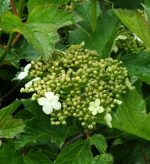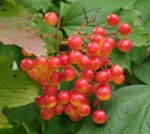 European cranberry is a large deciduous suckering shrub and a member of the moschatel family, Adoxaceae, a small family of flowering plants that includes viburnums and elders. It is native to Europe and North Africa and northern Asia where it is found in wet, swampy sites, but was introduced into the North America as an ornamental and has become invasive in some states. Plants grow 8-12’ tall and have coarsely toothed, three-lobed leaves that are dark green until fall when they turn red or red –purple. In late spring to early summer 3.5” wide terminal clusters of small white fertile flowers surrounded by showy sterile flowers appear and are followed by edible red berry-like fruit that are attractive to birds and other wildlife. European cranberry has been used as a specimen, and in foundation plantings, mixed borders, hedges and screens. The genus name, Viburnum, is the Latin name for the wayfaring tree. The specific epithet and varietal name, opulus, comes from the Latin word ops, meaning power or influence.
European cranberry is a large deciduous suckering shrub and a member of the moschatel family, Adoxaceae, a small family of flowering plants that includes viburnums and elders. It is native to Europe and North Africa and northern Asia where it is found in wet, swampy sites, but was introduced into the North America as an ornamental and has become invasive in some states. Plants grow 8-12’ tall and have coarsely toothed, three-lobed leaves that are dark green until fall when they turn red or red –purple. In late spring to early summer 3.5” wide terminal clusters of small white fertile flowers surrounded by showy sterile flowers appear and are followed by edible red berry-like fruit that are attractive to birds and other wildlife. European cranberry has been used as a specimen, and in foundation plantings, mixed borders, hedges and screens. The genus name, Viburnum, is the Latin name for the wayfaring tree. The specific epithet and varietal name, opulus, comes from the Latin word ops, meaning power or influence.
 Type: Deciduous shrub
Type: Deciduous shrub
Outstanding Feature: Flowers, berries
Form: Rounded, spreading
Growth Rate: Moderate
Bloom: Small fertile and infertile white flowers in terminal cluster 3.5” wide in late spring to early summer
Size: 8-12’ H x 10-15’ W
Light: Full sun to part shade
Soil: Average, moist, well-drained
Hardiness: Zones 3-8
Care: Prune to remove oldest stems
Pests and Diseases: Aphids, viburnum crown borer, viburnum beetle, leaf spot
Propagation: Seed, cuttings
Comments: The native variety, Viburnum opulus var. americanum has the same ornamental features and is recommended as an alternative.